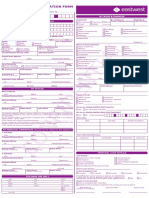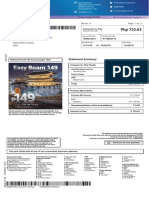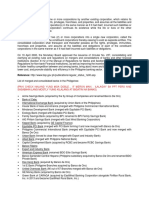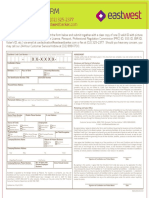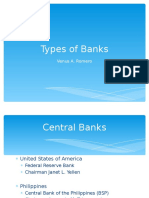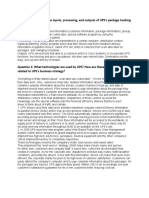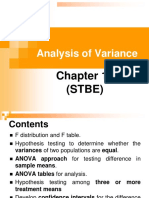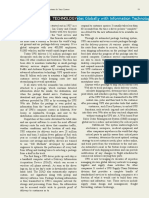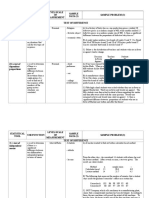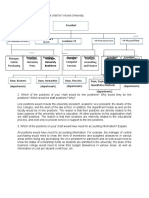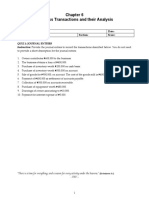Classifications of Bank and Exaample
Classifications of Bank and Exaample
Uploaded by
Josel AposagaCopyright:
Available Formats
Classifications of Bank and Exaample
Classifications of Bank and Exaample
Uploaded by
Josel AposagaCopyright
Available Formats
Share this document
Did you find this document useful?
Is this content inappropriate?
Copyright:
Available Formats
Classifications of Bank and Exaample
Classifications of Bank and Exaample
Uploaded by
Josel AposagaCopyright:
Available Formats
List of Philippine Rural Banks Under BSP
PHILIPPINE RURAL BANKS – Here is a list of more than 100 rural banks in the Philippines.
Currently, there are more than a hundred banks in the Philippines including the subsidiaries of
giant banking companies. Some of these banks belong to the Philippine Commercial Banks and
the Philippine Savings Banks.
PHILIPPINE RURAL BANKS
1. One Network Bank, Inc. (a subsidiary of Banco de Oro)
2. EastWest Rural Bank, Inc. (a subsidiary of EastWest Bank)
3. CARD Bank, Inc. (a MF RB)
4. Guagua Rural Bank, Inc.
5. First Isabela Cooperative Bank (FICO Bank)
6. GM Bank of Luzon, Inc. (a rural bank)
7. Quezon Capital Rural Bank, Inc.
8. Metro South Cooperative Bank
9. BOF, Inc. (a rural bank)
10. AMA Rural Bank of Mandaluyong, Inc.
11. Rang-ay Bank, Inc. (a rural bank)
12. Katipunan Bank, Inc. (a rural bank)
13. Cantilan Bank, Inc. (a rural bank)
14. Dumaguete Rural Bank Inc. (DRBI)
15. Rizal Bank (a MF RB)
16. Banco Dipolog (a rural bank; subsidiary of the Philippine Bank of Communications)
17. Country Builders Bank, Inc. (a rural bank)
18. Summit Bank (rural bank of Tublay, Inc.)
19. Rural Bank of Angeles, Inc. (A subsidiary of Asia United Bank Corporation)
20. Banco Mabuhay (a rural bank)
21. Marayo Bank, Inc. (a rural bank)
22. Cooperative Bank of Cotabato
23. Insular Savers Bank, Inc. (a rural bank)
24. Rural Bank of Cauayan, Inc.
25. New Rural Bank of San Leonardo (N.E.) Inc.
26. Rural Bank of Pandi (Bulacan) Inc.
27. People’s Rural Bank (Gen. Santos City) Inc.
28. MVSM Bank (a rural bank since 1953) Inc.
29. Camalig Bank, Inc. (a rural bank)
30. Consolidated Cooperative Bank
31. Rural Bank of Barili (Cebu) Inc.
32. Imus Rural Bank, Inc.
33. Bankways, Inc. (a rural bank)
34. SPAC Rural Bank, Inc.
35. PlanBank (Rural Bank of Canlubang Planters, Inc.)
36. Rural Bank of Central Pangasinan (Bayambang) Inc.
37. Rural Bank of Digos, Inc.
38. Rural Bank of Magdalena (Laguna) Inc.
39. Mount Makiling Rural Bank, Inc.
40. First Tagum Rural Bank, Inc.
41. Valiant Bank, Inc. (a rural bank)
42. Gateway Rural Bank, Inc.
43. LifeBank (a rural bank)
44. Malarayat Rural Bank, Inc.
45. Rural Bank of San Mateo (Isabela) Inc.
46. Mallig Plains Rural Bank (ISA) Inc.
47. Highland Rural Bank, Inc.
48. Cooperative Bank of Quezon Province
49. Mactan Rural Bank (Lapu-Lapu City) Inc.
50. Rural Bank of Bambang (Nueva Vizcaya) Inc.
51. Ilocos Sur Cooperative Bank
52. Rural Bank of Pola (Oriental Mindoro)
53. Cooperative Bank of Ilocos Norte
54. RBT Bank, Inc. (a rural bank)
55. Rural Bank of Rizal (Zamboanga del Norte) Inc.
56. Rural Bank of Gattaran (Cagayan) Inc.
57. Laguna Prestige Banking Corporation (a rural bank)
58. Rural Bank of Maria Aurora (Aurora) Inc.
59. Rural Bank of Itogon (Benguet) Inc.
60. Rural Bank of Pilar (Bataan) Inc.
61. BHF Rural Bank, Inc.
62. Network Consolidated Cooperative Bank
63. Rural Bank of Sta. Ignacia, Inc.
64. Entrepreneur Rural Bank, Inc.
65. Rural Bank of Rosario (La Union) Inc.
66. Saviour Rural Bank, Inc.
67. Rural Bank of Tangub City (Misamis Occidental) Inc.
68. Rural Bank of General Trias, Inc.
69. D’ Asian Hills Bank, Inc. (a rural bank)
70. Community Rural Bank of Catmon (Cebu) Inc.
71. Aliaga Farmers Rural Bank, Inc.
72. Rural Bank of San Antonio, Inc.
73. Rural Bank of Dumangas, Inc.
74. Rural Bank of Bayombong, Inc.
75. Rural Bank of San Pascual (Obando, Bulacan) Inc.
76. Cooperative Bank of Nueva Vizcaya
77. Rural Bank of Bagabag (N.V.) Inc.
78. Rural Bank of Solano (Nueva Vizcaya) Inc.
79. Sugbuanon Rural Bank, Inc.
80. Rural Bank of Montalban, Inc.
81. RBG Imperial Bank, Inc. (a rural bank)
82. Banco Laguna, Inc. (a rural bank since 1965)
83. Rural Bank of Dolores (Quezon) Inc.
84. Cebuana Lhuillier Rural Bank, Inc.
85. Rural Bank of Lebak (Sultan Kudarat) Inc.
86. Rural Bank of Cardona (Rizal) Inc.
87. Innovative Bank, Inc. (a rural bank)
88. Common Wealth Rural Bank, Inc.
89. Cooperative Bank of Bohol
90. Liberty Bank (a rural bank)
91. Sta. Maria Rural Bank, Inc.
92. Rural Bank of Guinobatan, Inc.
93. Balanga Rural Bank, Inc.
94. Rural Bank of Maragondon, Inc.
95. Rural Bank of Jaen, Inc.
96. Rural Bank of Paracale (Camarines Norte) Inc.
97. Community Rural Bank of Dapitan City, Inc.
98. Cavite United Rural Bank Corporation (A subsidiary of Asia United Bank Corporation)
99. Rural Bank of Mangaldan
100. Rural Bank of Mabalacat, Inc.
101. Opportunity Kauswagan Inc. (a microfinance rural bank)
102. First Agro-Industrial Rural Bank, Inc. / FAIRBANK Inc.
Here is the full list of the Philippine commercial banks:
BDO Unibank, Inc.
Metropolitan Bank and Trust Company (Metrobank)
Bank of the Philippine Islands (BPI)
Land Bank of the Philippines
Philippine National Bank (PNB)
Security Bank Corporation (Security Bank)
China Banking Corporation (Chinabank)
Development Bank of the Philippines (DBP)
Union Bank of the Philippines, Inc. (Unionbank)
Rizal Commercial Banking Corporation (RCBC)
United Coconut Planters Bank (UCPB)
East West Banking Corporation (EastWest Bank)
Citibank Philippines
Asia United Bank Corporation (AUB)
The Hongkong and Shanghai Banking Corporation Limited (HSBC)
Philippine Trust Company (Philtrust Bank)
Bank of Commerce (a subsidiary of San Miguel Corporation)
Maybank Philippines, Inc.
Robinsons Bank Corporation
Philippine Bank of Communications (PBCom)
Mizuho Bank, Ltd. Manila Branch
MUFG Bank, Ltd.
BDO Private Bank (subsidiary of Banco de Oro)
Standard Chartered Bank Philippines
Deutsche Bank
Philippine Veterans Bank (Veterans Bank; PVB)
CTBC Bank (Chinatrust)
JPMorgan Chase & Co. (JPMorgan Chase)
Australia and New Zealand Banking Group (ANZ)
Sumitomo Mitsui Banking Corporation Manila Branch
ING Group N.V.
Bank of America, N.A.
Bank of China – Manila Branch
Mega International Commercial Bank Co. LTD
KEB Hana Bank – Manila Branch
Bangkok Bank Co. Ltd.
Industrial Bank of Korea Manila Branch
United Overseas Bank Limited Manila Branch
Cathay United Bank Co. Ltd. – Manila Branch
Shinhan Bank – Manila Branch
Hua Nan Commercial Bank Ltd. Manila
First Commercial Bank Manila
Al-Amanah Islamic Investment Bank of the Philippines
Three are universal banks and one is a thrift bank.
Land Bank of the Philippines
LandBank Plaza Bldg.
1598 M. H. Del Pilar cor. Dr. J. Quintos St.
Malate, Manila 1004
– No. of Offices: 370
– Founded in 1963
– Became a universal bank in 1973
Development Bank of the Philippines
Headquarters:
Gil Puyat Avenue corner Makati Avenue
Makati City
– No. of Offices: 113
– Started as Agricultural and Industrial Bank in 1939
– Renamed Development Bank of the Philippines in 1958
– Became a universal bank in 1995
Al-Amanah Islamic Investment Bank of the Philippines
Headquarters:
PHIDCO A. Building
Veterans Avenue, Zamboanga City
Executive Office:
4th Floor Development Bank of the Philippines
Gil Puyat Avenue corner Makati Avenue
Makati City 1200
No. of Offices: 9
– Started in 1973 as Philippine Amanah Bank
– Renamed Al-Amanah Islamic Investment Bank of the Philippines in 1990
– Only bank authorized to operate under Islamic banking concepts
– Owned and controlled by the Development Bank of the Philippines
Overseas Filipino Bank, A Savings Bank of LandBank
(formerly Philippine Postal Savings Bank)
– was created to cater to the banking needs of OFWs, other overseas Filipinos and their
families
– was ceremonially launched by Pres. Duterte on January 18, 2018
– was created in September 2017 when Pres. Rodrigo Duterte issued Executive Order No.
44 approving the acquisition of the Philippine Postal Savings Bank by Landbank and
conversion into Overseas Filipino Bank.
Does the government own UCPB?
Yes, the government owns 73.9%% of UCPB. After years of court battles regarding UCPB
ownership, the Supreme Court ruled with finality in 2013 that the Philippine government
owns 72.2% of UCPB. Currently, UCPB is a government owned and controlled corporation
(GOOC) and a state depository bank. The government does not plan to run UCPB as a
government bank, so it has been working with the Department of Finance on its
privatization.
UCPB was originally First United Bank (FUB). It was renamed United Coconut Planters
Bank (UCPB) in 1975 after 72.2% of it was purchased by a government agency, the
Philippine Coconut Authority (PCA), using coconut levy funds. These funds were taxes
collected from coconut farmers from 1972 to 1982.
Isn’t Union Bank one of the government banks in the Philippines?
No. But the government-owned corporation SSS owns 13.99% of Union Bank.
What is Union Bank’s relationship with the SSS?
SSS is one of the 3 biggest shareholders of Union Bank. SSS, a government owned and
controlled corporation (GOCC), owns 13.99% of Union Bank, as of June 2018.
Is Philippine National Bank (PNB) a Government Bank?
No. Hindi na.
The Philippine National Bank (PNB) was created as a government bank in 1916, but it
started getting privatized in 1989 when its stocks were listed in the stock exchange.
In 1996, PNB became a private bank when the government’s ownership was reduced to
46%.
In 1999, a group led by Lucio Tan acquired 35% of the bank and increased its ownership to
69.32% in 2000. It further increased its ownership to 77.43% in 2005.
In 2007, the government sold all its remaining shares in PNB to the public.
The BSP monitors and compiles various indicators on the Philippine banking system. The Philippine
banking system is composed of universal and commercial banks, thrift banks, rural and cooperative
banks.
Universal and commercial banks represent the largest single group, resource-wise, of financial
institutions in the country. They offer the widest variety of banking services among financial institutions. In
addition to the function of an ordinary commercial bank, universal banks are also authorized to engage in
underwriting and other functions of investment houses, and to invest in equities of non-allied
undertakings.
The thrift banking system is composed of savings and mortgage banks, private development banks,
stock savings and loan associations and microfinance thrift banks. Thrift banks are engaged in
accumulating savings of depositors and investing them. They also provide short-term working capital and
medium- and long-term financing to businesses engaged in agriculture, services, industry and housing,
and diversified financial and allied services, and to their chosen markets and constituencies, especially
small- and medium- enterprises and individuals.
Rural and cooperative banks are the more popular type of banks in the rural communities. Their role is
to promote and expand the rural economy in an orderly and effective manner by providing the people in
the rural communities with basic financial services. Rural and cooperative banks help farmers through the
stages of production, from buying seedlings to marketing of their produce. Rural banks and cooperative
banks are differentiated from each other by ownership. While rural banks are privately owned and
managed, cooperative banks are organized/owned by cooperatives or federation of cooperatives.
You might also like
- East West Bank FormDocument2 pagesEast West Bank FormRonald Tan100% (1)
- Statement of Account: Summary of Charges and CreditsDocument3 pagesStatement of Account: Summary of Charges and CreditsRye LozadaNo ratings yet
- JLORENO Globe Billing 719Document3 pagesJLORENO Globe Billing 719noibagng928krNo ratings yet
- MergerDocument6 pagesMergerAyrah Erica Jaime100% (1)
- EastWest Activation FormDocument1 pageEastWest Activation FormAntonette Lim0% (1)
- Application Form-June 2018Document2 pagesApplication Form-June 2018Jerrie lyn engalla100% (1)
- Í DL) 'È TABILIRAN ELIZABETHÂÂ L Çg. - 4HÎ Mrs. Elizabeth Lamdag TabiliranDocument3 pagesÍ DL) 'È TABILIRAN ELIZABETHÂÂ L Çg. - 4HÎ Mrs. Elizabeth Lamdag TabiliranElro Mar TabiliranNo ratings yet
- Auto Loan Data Completion Sheet 11.5.19Document9 pagesAuto Loan Data Completion Sheet 11.5.19Maria AlvarezNo ratings yet
- Types of Bank: Lima, Camille Jane L. Prof. Cesar Cruel 3-FM5 MW 4:00-5:30 PMDocument4 pagesTypes of Bank: Lima, Camille Jane L. Prof. Cesar Cruel 3-FM5 MW 4:00-5:30 PMcamille janeNo ratings yet
- Universal and Commercial Banks in The PhilippinesDocument1 pageUniversal and Commercial Banks in The Philippinesjohngo888No ratings yet
- Types of Banks in The PhilippinesDocument13 pagesTypes of Banks in The PhilippinesHarka MeeNo ratings yet
- Foreign RRLDocument4 pagesForeign RRLJeremy Angelo100% (1)
- Elofe Coffee Shop ProjectDocument13 pagesElofe Coffee Shop Projectflorie.vhel2003100% (1)
- Question 1: What Are The Inputs, Processing, and Outputs of UPS's Package Tracking System?Document2 pagesQuestion 1: What Are The Inputs, Processing, and Outputs of UPS's Package Tracking System?Sifat Shaharia100% (1)
- Q1. What Are The Inputs, Processing, and Outputs of UPS's Package Tracking System?Document3 pagesQ1. What Are The Inputs, Processing, and Outputs of UPS's Package Tracking System?Desmond B. Okyere100% (1)
- Ayesha 2013503630 - MIS 107mid1 (Chapters 1, 4 & 7) (Sec21) Summer2021Document6 pagesAyesha 2013503630 - MIS 107mid1 (Chapters 1, 4 & 7) (Sec21) Summer2021Ayesha Rahman100% (1)
- MIS Management Information SystemDocument19 pagesMIS Management Information SystemNamrata Joshi100% (1)
- Chapter 1 - Philippine Financial SystemDocument37 pagesChapter 1 - Philippine Financial SystemNicole LasiNo ratings yet
- Introduction To Money Payment System-2Document42 pagesIntroduction To Money Payment System-2lawwrrance chanNo ratings yet
- Case Study 3 - JIT at Arnold Palmer HospitalDocument3 pagesCase Study 3 - JIT at Arnold Palmer HospitalAparajita Singh100% (1)
- Chapter 7 Change ManagementDocument11 pagesChapter 7 Change ManagementPhương Quỳnh100% (1)
- Chapter 2 Philippine Financial SystemDocument53 pagesChapter 2 Philippine Financial SystemmeyvvNo ratings yet
- Thrift Banks ActDocument25 pagesThrift Banks ActMadelle Pineda100% (1)
- Rizal Chapter 1Document33 pagesRizal Chapter 1Hanne FuentesNo ratings yet
- Chap 12 - Analysis of VarianceDocument55 pagesChap 12 - Analysis of VariancemechafuadNo ratings yet
- UPS Competes Globally With Information TechnologyDocument2 pagesUPS Competes Globally With Information TechnologyRizky Agung100% (1)
- Consumer Rights and ResponsibilitiesDocument2 pagesConsumer Rights and ResponsibilitiesMel Louise M. Dumot (Mellow)No ratings yet
- UPS Case StudyDocument1 pageUPS Case StudyMohammad Al HumeriNo ratings yet
- Chapter 12Document44 pagesChapter 12Toto AmuroNo ratings yet
- Chapter 2 Organizational PlanDocument9 pagesChapter 2 Organizational PlanashifaNo ratings yet
- Ch01-An Introduction To Information SystemsDocument53 pagesCh01-An Introduction To Information SystemsNoor Mohd EffendiNo ratings yet
- Module 2 - Product in Theory and PracticeDocument8 pagesModule 2 - Product in Theory and PracticeRonald Reagan AlonzoNo ratings yet
- Preface: What Is The Tax Planning ?Document29 pagesPreface: What Is The Tax Planning ?SpUnky RohitNo ratings yet
- Chapter 5 ProductDocument39 pagesChapter 5 ProductNguyễn VyNo ratings yet
- Cecchetti-5e-Ch12 - Depository Institutions, Banks and Bank ManagementDocument70 pagesCecchetti-5e-Ch12 - Depository Institutions, Banks and Bank ManagementammendNo ratings yet
- Statistical ToolsDocument6 pagesStatistical ToolsQueency B CametNo ratings yet
- A Study On Marketing Strategies Towards Social Media MarketingDocument107 pagesA Study On Marketing Strategies Towards Social Media MarketingYash Karande100% (1)
- Cecchetti 6e Chapter 01Document18 pagesCecchetti 6e Chapter 01Karthik LakshminarayanNo ratings yet
- Transportation AlgorithmDocument41 pagesTransportation AlgorithmBinyam Kebede100% (1)
- Defining The Marketing Research Problem and Developing An Approach - FinalDocument45 pagesDefining The Marketing Research Problem and Developing An Approach - FinalSajin Sunny100% (2)
- The Fundamentals of Investing PPT 2.4.4.G1Document36 pagesThe Fundamentals of Investing PPT 2.4.4.G1Lùh HùñçhòNo ratings yet
- Verona UniversityDocument1 pageVerona UniversityMohammad Farhan SafwanNo ratings yet
- Cecchetti-5e-Ch01 - Intro To Money and Financial SystemDocument20 pagesCecchetti-5e-Ch01 - Intro To Money and Financial SystemammendNo ratings yet
- 4.1 RA 7394 Consumer ActDocument12 pages4.1 RA 7394 Consumer ActChristian Cristo BananiaNo ratings yet
- Corporate GovernanceDocument86 pagesCorporate GovernanceTripathi Oj0% (1)
- Product and Brand DecisionDocument43 pagesProduct and Brand Decisionwillis_dsouzaNo ratings yet
- Lesson 1: Nature, Purpose, and Scope of Financial Management Learning ObjectivesDocument6 pagesLesson 1: Nature, Purpose, and Scope of Financial Management Learning ObjectivesAngelyn MortelNo ratings yet
- Secondary SourcesDocument8 pagesSecondary Sourceslene100% (1)
- 1 Inocencio 072418Document17 pages1 Inocencio 072418Felizardo GuiananNo ratings yet
- Quizzes - Chapter 6 - Business Transactions & Their AnalysisDocument6 pagesQuizzes - Chapter 6 - Business Transactions & Their AnalysisClint Abenoja100% (1)
- Overview of WalmartDocument4 pagesOverview of WalmartAkriti SehgalNo ratings yet
- Nstp-Cwts 1: Ms. Sheila Mae C. PogoyDocument13 pagesNstp-Cwts 1: Ms. Sheila Mae C. PogoyNeal John VillarmenteNo ratings yet
- Credit, Its Uses, Classifications, and RisksDocument18 pagesCredit, Its Uses, Classifications, and RisksAnna Rose T. MarcelinoNo ratings yet
- 4.1 Debt and Equity FinancingDocument13 pages4.1 Debt and Equity FinancingAliza UrtalNo ratings yet
- Investment Slide 1Document17 pagesInvestment Slide 1ashoggg0% (1)
- Ratio AnalysisDocument4 pagesRatio AnalysisdattacuriousNo ratings yet
- Insurance Companies - Size, Structure, and Composition of The IndustryDocument15 pagesInsurance Companies - Size, Structure, and Composition of The IndustryKEVIN C. LEALDENo ratings yet
- Course Material - Banking and Financial InstitutionsDocument27 pagesCourse Material - Banking and Financial InstitutionsJAMES CRISTOFER TARROZANo ratings yet
- Business MarketDocument10 pagesBusiness MarketWaleed AbbasiNo ratings yet
- Megaworld Corporation: Presented By: Violeta C. Sia John Dimarzio R. CornejoDocument24 pagesMegaworld Corporation: Presented By: Violeta C. Sia John Dimarzio R. CornejoVioletNo ratings yet
- Cash ManagementDocument26 pagesCash ManagementshrNo ratings yet
- Levels of MeasurementDocument24 pagesLevels of MeasurementMakhdoom Ibad HashmiNo ratings yet
- Cecchetti-5e-Ch03 - Financial Instruments, Financial MarketsDocument58 pagesCecchetti-5e-Ch03 - Financial Instruments, Financial MarketsammendNo ratings yet
- Finance - Working-Capital-PolicyDocument28 pagesFinance - Working-Capital-PolicyTrishia Lynn MartinezNo ratings yet
- FM Quiz #3 SET 1Document2 pagesFM Quiz #3 SET 1Cjhay MarcosNo ratings yet
- FinanceDocument5 pagesFinanceAena GanuelasNo ratings yet
- NothingDocument4 pagesNothingSofia Louisse C. FernandezNo ratings yet
- General List of Banks of The PhilippinesDocument16 pagesGeneral List of Banks of The PhilippinesOkin Nawa100% (1)
- Ewb MorenoDocument4 pagesEwb MorenoLyra MorenoNo ratings yet
- Eastwest Visa 4126-1186-8294-3015 43,000.00 20,608.41 21,500.00 3.50%Document4 pagesEastwest Visa 4126-1186-8294-3015 43,000.00 20,608.41 21,500.00 3.50%vlabrague6426No ratings yet
- 2018 Annual Report - Information StatementsDocument68 pages2018 Annual Report - Information StatementsJOSE KARLO MARI TOTTOCNo ratings yet
- 2020 06 20 FDC Annual Report 2019 v4 Email Fa PDFDocument70 pages2020 06 20 FDC Annual Report 2019 v4 Email Fa PDFJulmar MisaNo ratings yet
- List BancNet Member BanksDocument2 pagesList BancNet Member BanksTara NahNo ratings yet
- East West BankDocument2 pagesEast West BankHowie MalikNo ratings yet
- Globe Bill NullDocument3 pagesGlobe Bill NullNeriliza Dela CenaNo ratings yet
- Performance Task in General Mathematics: Grade 11-Archdiocese of Nuevasegovia (Inocenciog., Romualdo, Medina, Sagutin)Document18 pagesPerformance Task in General Mathematics: Grade 11-Archdiocese of Nuevasegovia (Inocenciog., Romualdo, Medina, Sagutin)Sheila Formentera-AlfonsoNo ratings yet
- JJHBBDocument7 pagesJJHBBAngelica M. ManagaNo ratings yet
- Classifications of Bank and ExaampleDocument6 pagesClassifications of Bank and ExaampleJosel AposagaNo ratings yet
- Long Term Bond FundDocument1 pageLong Term Bond FundYannah HidalgoNo ratings yet
- Imus Campus Cavite Civic Center Palico IV, Imus, CaviteDocument13 pagesImus Campus Cavite Civic Center Palico IV, Imus, CaviterueNo ratings yet
- H Paper EastWest Bank 2Document4 pagesH Paper EastWest Bank 2Justin Dan A. OrculloNo ratings yet
- FAQs Instapay & PESONetDocument2 pagesFAQs Instapay & PESONetLeanne AfsheenNo ratings yet
- Í N Zcè Yalung Ma - Âluzâââââââ C Ç4) $83, Î Mrs. Ma. Luz Cura YalungDocument7 pagesÍ N Zcè Yalung Ma - Âluzâââââââ C Ç4) $83, Î Mrs. Ma. Luz Cura YalungKevin YalungNo ratings yet
- The Birth of EastWest BankDocument6 pagesThe Birth of EastWest Bankpaulinesarte0No ratings yet
- Í E D, È Raquit Ramilâââââââââ M Çrâ) - 4?Î Mr. Ramil Misterio RaquitDocument4 pagesÍ E D, È Raquit Ramilâââââââââ M Çrâ) - 4?Î Mr. Ramil Misterio RaquitRamil RaquitNo ratings yet
- Í H'Riè Telmo Johnâpatrickâââ P Çi6) - 5zî Mr. John Patrick Panganiban TelmoDocument3 pagesÍ H'Riè Telmo Johnâpatrickâââ P Çi6) - 5zî Mr. John Patrick Panganiban TelmoAl-ajim HadjiliNo ratings yet
- ASSIGNMENT-WPS OfficeDocument6 pagesASSIGNMENT-WPS Officemarianinadiapera8No ratings yet
- List of OPS With Certificate of Registration (COR) : Business/Trade Name Registration No. Date of Issuance Company NameDocument6 pagesList of OPS With Certificate of Registration (COR) : Business/Trade Name Registration No. Date of Issuance Company Namefranco dageletNo ratings yet
- Í Vjbxè Magno Joyâreihannahââ P Çäâ,-3Ãî Mrs. Joy Reihannah Paguital MagnoDocument7 pagesÍ Vjbxè Magno Joyâreihannahââ P Çäâ,-3Ãî Mrs. Joy Reihannah Paguital MagnoRein PMNo ratings yet
- Í Ä43Dè Llacuna Ginaâââââââââ D Çu#&25@Î Mrs. Gina de Jesus LlacunaDocument2 pagesÍ Ä43Dè Llacuna Ginaâââââââââ D Çu#&25@Î Mrs. Gina de Jesus LlacunaShan ArtNo ratings yet
